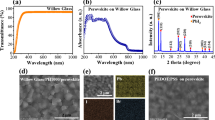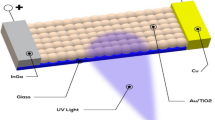Abstract
Ultraviolet (UV) detectors are used in diverse areas of light detection and image analysis, such as astronomy, medicine, and environmental monitoring. Most of the UVC emitted from the sun is absorbed by ozone and does not reach the earth's surface; as a result, only a weak signal is detected. However, UVC is also produced by artificial sources and can have detrimental effects on health and materials. To measure UVC accurately it is desirable to develop a semiconductor UVC photodetector that converts an incident optical signal into an electrical signal for analysis. Recently, ultraviolet detectors based on the semiconductor characteristics of perovskite have attracted attention. Perovskite effectively absorbs a wide range of wavelengths and has high charge-carrier mobility. In this study, the (FAPbI3)x(MAPbI3)1-x mixed cation perovskite was used as the light-absorbing layer of a photodetector. The parameters investigated in this study are showing the performance of the photodetector, including the on/off ratio, responsivity, detectivity, and external quantum efficiency. (FAPbI3)0.925(MAPbI3)0.075 film has a high on/off ratio of 877, a responsivity of 5.87 mA/W, a detectivity of 4.15 × 1012, and an external quantum efficiency of 28.7%. These results suggest that perovskite prepared with mixed cations can be a promising candidate for UV C photodetector materials.







Similar content being viewed by others
Availability of data and materials
The data are available upon reasonable request from the corresponding author.
References
L. Shi, S. Nihtianov, Comparative study of silicon-based ultraviolet photodetectors. IEEE Sens. J. 12(7), 2453–2459 (2012)
J. Yao, G. Yang, 2D material broadband photodetectors. Nanoscale 12(2), 454–476 (2020)
S.H. Tsai, S. Basu, C.Y. Huang, L.C. Hsu, Y.G. Lin, R.H. Horng, Deep-ultraviolet photodetectors based on epitaxial ZnGa2O4 thin films. Sci. Rep. 8(1), 1–91 (2018)
Y. Zou, Y. Zhang, Y. Hu, H. Gu, Ultraviolet detectors based on wide bandgap semiconductor nanowire: a review. Sensors. 18(7), 2072 (2018). https://doi.org/10.3390/s18072072
C.C. Gomes, S. Preto, in Intelligent Human Systems Integration, IHSI 2018, Advances in Intelligent Systems and Computing, vol. 722, ed. by W. Karwowski, T. Ahram (Springer, Cham, 2018)
A.J. Dixon, B.F. Dixon, Ultraviolet radiation from welding and possible risk of skin and ocular malignancy. Med. J. Aust. 181(3), 155–157 (2004)
S.F. Leung, K.T. Ho, P.K. Kung, V.K. Hsiao, H.N. Alshareef, Z.L. Wang, J.H. He, A self-powered and flexible organometallic halide perovskite photodetector with very high detectivity. Adv. Mater. 30, 1704611 (2018)
Z.G. Ju, C.X. Shan, D.Y. Jiang, J.Y. Zhang, B. Yao, D.X. Zhao, D.Z. Shen, X.W. Fan, MgxZn1−xO-based photodetectors covering the whole solar-blind spectrum range. Appl. Phys. Lett. 93(17), 173505 (2008)
Y. Dkhissi, F. Huang, S. Rubanov, M. Xiao, U. Bach, L. Spiccia, R.A. Caruso, Y.B. Cheng, Low temperature processing of flexible planar perovskite solar cells with efficiency over 10%. J. Power Sources 278, 325–331 (2015)
A.A. Petrov, N.A. Belich, A.Y. Grishko, N.M. Stepanov, S.G. Dorofeev, E.G. Maksimov, A.V. Shevelkov, S.M. Zakeeruddin, M. Graetzel, A.B. Tarasov, E.A. Goodilin, A new formation strategy of hybrid perovskites via room temperature reactive polyiodide melts. Mater. Horiz. 4(4), 625–632 (2017)
Y. Li, Z.F. Shi, X.J. Li, C.X. Shan, Photodetectors based on inorganic halide perovskites: materials and devices. Chin. Phys. B 28(1), 017803 (2019)
X. Hu, X. Zhang, L. Liang, J. Bao, S. Li, W. Yang, Y. Xie, High-performance flexible broadband photodetector based on organolead halide perovskite. Adv. Funct. Mater. 24(46), 7373–7380 (2014)
H. Park, S. Kumar, S. Chawla, F. El-Mellouhi, Design principles of large cation incorporation in halide perovskites. Molecules 26(20), 6184 (2021)
T.M. Koh, K. Thirumal, H.S. Soo, N. Mathews, Multidimensional perovskites: a mixed cation approach towards ambient stable and tunable perovskite photovoltaics. Chemsuschem 9(18), 2541–2558 (2016)
M. Mateen, Z. Arain, C. Liu, Y. Yang, X. Liu, Y. Ding, P. Shi, Y. Ren, Y. Wu, S. Dai, T. Hayat, A. Alsaedi, High-quality (FA)x(MA)1–xPbI3 for efficient perovskite solar cells via a facile cation-intermixing technique. ACS. Sustain. Chem. Eng. 7(13), 11760–11768 (2019)
D. Bi, W. Tress, M.I. Dar, P. Gao, J. Luo, C. Renevier, K. Schenk, A. Abate, F. Giordano, J.C. Baena, J. Decoppet, S.M. Zakeeruddin, M.K. Nazeeruddin, M. Gratzel, A. Hagfeldt, Efficient luminescent solar cells based on tailored mixed-cation perovskites. Sci. Adv. 2(1), e1501170 (2016)
X. Guo, K. Ngai, M. Qin, X. Lu, J. Xu, M. Long, The compatibility of methylammonium and formamidinium in mixed cation perovskite: the optoelectronic and stability properties. Nanotechnology 32, 075406 (2020)
W.G. Li, H.S. Rao, H.S.B.X. Chen, X.D. Wang, D.B. Kuang, A formamidinium–methylammonium lead iodide perovskite single crystal exhibiting exceptional optoelectronic properties and long-term stability. J. Mater. Chem. A 5(36), 19431–19438 (2017)
D. Zhou, T. Zhou, Y. Tian, X. Zhu, Y. Tu, Perovskite-based solar cells: materials, methods, and future perspectives. J. Nanomater. 2018, 8148072 (2018)
S. Tang, X. Xiao, J. Hu, B. Gao, H. Chen, Z. Zuo, Q. Qi, Z. Peng, J. Wen, D. Zou, Mechanochemical synthesis of pure phase mixed-cation/anion (FAPbI3)x(MAPbBr3)1–x hybrid perovskite materials: compositional engineering and photovoltaic performance. RSC. Adv. 11(11), 5874–5884 (2021). https://doi.org/10.1039/d0ra10751d
S. Yu, H. Liu, S. Wang, H. Zhu, X. Dong, X. Li, Hydrazinium cation mixed FAPbI3-based perovskite with 1D/3D hybrid dimension structure for efficient and stable solar cells. Chem. Eng. J. 403, 125724 (2021)
D. Shan, G. Tong, Y. Cao, M. Tang, J. Xu, L. Yu, K. Chen, The effect of decomposed PbI2 on microscopic mechanisms of scattering in CH3NH3PbI3 films. Nanoscale Res. Lett. 14(1), 1–6 (2019)
X. Li, J. Yang, Q. Jiang, W. Chu, D. Zhang, Z. Zhou, Y. Ren, J. Xin, Enhanced photovoltaic performance and stability in mixed-cation perovskite solar cells via compositional modulation. Electrochim. Acta. 247, 460–467 (2017)
L. Atourki, E. Vega, B. Marí, M. Mollar, H.A. Ahsaine, K. Bouabid, A. Ihlal, Role of the chemical substitution on the structural and luminescence properties of the mixed halide perovskite thin MAPbI3−xBrx (0 ≤ x ≤ 1) films. Appl. Surf. Sci. 2016(371), 112–117 (2016)
A. Amat, E. Mosconi, E. Ronca, C. Quarti, P. Umari, M.K. Nazeeruddin, M. Gratzel, F.D. Angelis De Angelis, Cation-induced band-gap tuning in organohalide perovskites: interplay of spin–orbit coupling and octahedra tilting. Nano Lett. 14(6), 3608–3616 (2014)
S. Koizumi, H. Umezawa, J. Pernot, M. Suzuki, Power Electronics Device Applications of Diamond Semiconductors (Woodhead Publishing, Cambridge, 2018)
I. Yonenaga, Carrier mobility and resistivity of n-and p-type six Ge1-x (0.93 <x <0.96) single crystals. Jpn. J. Appl. Phys. 45(4), 2678 (2006)
A. Bercegol, D. Ory, D. Suchet, S. Cacovich, O. Fournier, J. Rousset, L. Lombez, Quantitative optical assessment of photonic and electronic properties in halide perovskite. Nat. Commun. 10(1), 1–8 (2019)
M. Myronov, Molecular Beam Epitaxy (Elsevier, Amsterdam, 2018), pp.37–54
G. Hodes, P.V. Kamat, Understanding the implication of carrier diffusion length in photovoltaic cells. J. Phys. Chem. Lett. 6(20), 4090–4092 (2015)
S.G. Shin, C.W. Bark, H.W. Choi, Study on performance improvements in perovskite-based ultraviolet sensors prepared using toluene antisolvent and CH3NH3Cl3. Nanomaterials 11(4), 1000 (2021)
J.H. Chen, Q. Jing, F. Xu, Y.Q. Lu, High-sensitivity optical-fiber-compatible photodetector with an integrated CsPbBr3–graphene hybrid structure. Optica 4(8), 835–838 (2017)
T.M.H. Nguyen, S.K. Lee, S.M. Kim, C.W. Bark, Solution-processed and self-powered photodetector in vertical architecture using mixed-halide perovskite for highly sensitive UVC detection. J. Phys. Chem. Lett. A. 9(2), 1269–1276 (2021)
T.M.H. Nguyen, S.K. Lee, S.M. Kim, C.W. Bark, Practical demonstration of deep-ultraviolet detection with wearable and self-powered halide perovskite-based photodetector. ACS Appl. Mater. Interfaces 13(48), 57609–57618 (2021)
P.F. Fettweis, J. Verplancke, R. Venkataraman, B.M. Young, H. Schwenn, In Handbook of Radioactivity Analysis, 2003, pp. 309–323. https://doi.org/10.1088/0026-1394/44/4/S09
M.D. Laurentis, A. Irace, Optical measurement techniques of recombination lifetime based on the free carriers absorption effect. J. Phys. C 2014, 291469 (2014). https://doi.org/10.1155/2014/291469
T. Zhang, F. Wang, P. Zhang, Y. Wang, H. Chen, J. Li, J. Wu, L. Chen, Z.D. Chen, S. Li, Low-temperature processed inorganic perovskites for flexible detectors with a broadband photoresponse. Nanoscale 11(6), 2871–2877 (2019)
Z.X. Zhang, C. Li, Y. Lu, X.W. Tong, F.X. Liang, X.Y. Zhao, D. Wu, C. Xie, L.B. Luo, Sensitive deep ultraviolet photodetector and image sensor composed of inorganic lead-free Cs3Cu2I5 perovskite with wide bandgap. J. Phys. Chem. Lett. 10(18), 5343–5350 (2019)
M.H. Tran, T. Park, J. Hur, Wide-bandgap CaSnO3 perovskite as an efficient and selective deep-UV absorber for self-powered and high-performance pin photodetector. ACS. Appl. Mater. Interfaces 13(11), 13372–13382 (2021)
T.C. Wei, D.S. Tsai, P. Ravadgar, J.J. Ke, M.L. Tsai, D.H. Lien, C.Y. Huang, R.H. Horng, J.H. He, See-through Ga2O3 solar-blind photodetectors for use in harsh environments. IEEE. J. Sel. Top. Quantum. Electron. 20(6), 112–117 (2014)
Q. Zhang, J. Jie, S. Diao, Z. Shao, Q. Zhang, L. Wang, W. Deng, W. Hu, H. Xia, X. Yuan, S.T. Lee, Solution-processed graphene quantum dot deep-UV photodetectors. ACS Nano 9(2), 1561–1570 (2015)
Acknowledgements
This research was supported by the Basic Science Research Capacity Enhancement Project through the Korea Basic Science Institute (National Research Facilities and Equipment Center) grant funded by the Ministry of Education (2019R1A6C1010016). This work was supported by the Korea Institute for Advancement of Technology (KIAT) grant funded by the Korean Government (MOTIE) (P0012451, The Competency Development Program for Industry Specialist).
Funding
The Author has received research support from the Ministry of Education.
Author information
Authors and Affiliations
Contributions
Investigation, GIC; validation GIC and HWC; writing—original draft preparation, GIC; writing—review and editing, GIC and HWC; supervision, HWC.
Corresponding author
Ethics declarations
Conflict of interest
The authors declare no conflict of interest.
Ethics approval
Not applicable.
Consent to participate
Not applicable.
Consent for publication
The author grants the publisher consent to publish.
Rights and permissions
Springer Nature or its licensor holds exclusive rights to this article under a publishing agreement with the author(s) or other rightsholder(s); author self-archiving of the accepted manuscript version of this article is solely governed by the terms of such publishing agreement and applicable law.
About this article
Cite this article
Choi, G.I., Choi, H.W. A study on mixed cation perovskite-based UVC photodetector with improved performance. J. Korean Ceram. Soc. 60, 90–98 (2023). https://doi.org/10.1007/s43207-022-00247-4
Received:
Revised:
Accepted:
Published:
Issue Date:
DOI: https://doi.org/10.1007/s43207-022-00247-4




